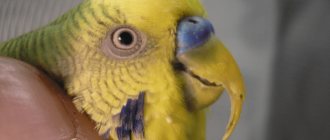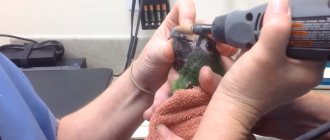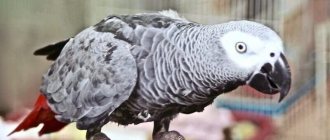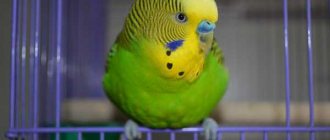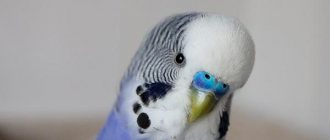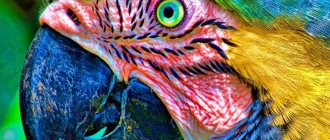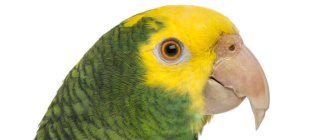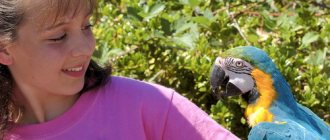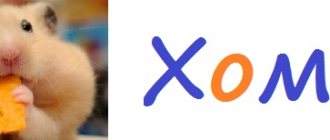- home
- Parrot
- FAQ
04/22/2019 The beak plays a very important role in the life of a parrot. With its help, birds get food, build their nest, and feed their chicks. It serves to tidy up the plumage. It is with its beak that the parrot helps itself when moving along the bars. In case of danger it serves as a defensive weapon. In nature, an abnormal deviation in its development or disease often leads to the death of a bird.
Beak diseases in parrots
Various viruses, fungal and bacterial infections lead to its damage. If you notice that the bird is bothered by itching, then you can suspect avian scabies - knemidocoptic mange. Scabies mites gnaw passages in the cornea. The area around and the organ itself becomes overgrown with spongy growths. Parrots are sometimes affected by fibrosarcoma, a bone tumor. Some viral infections cause changes in the bone part. A similar thing is quite possible from bird pox. It happens that the stratum corneum is divided into scales. This may be a consequence of poor nutrition. Treatment consists of eliminating this deficiency.
Sometimes the mucous surface of the beak becomes inflamed and a dense plaque forms. The bird is not able to completely capture the food. Due to swelling of the tongue, it becomes impossible to close it. Timely adequate treatment with antibiotics and increased doses of vitamin A will reverse the inflammatory process.
Causes of beak deformation
Owners bring their feathered pets with this anomaly to the veterinarian and ask why the parrot’s beak is crooked? The reasons leading to changes in this part of the head may be the following:
- A bruise or crack caused by hitting a window or furniture while free-flying around the room. In this case, the jaw bones shift, the functions of the organ are disrupted, and growths form.
- Sometimes a congenital anomaly occurs, which is a deviation and interferes with the normal respiratory process. The pet is viable, but needs careful care. Such distortions cannot be corrected.
- Diseases caused by parasites and various infections can also lead to changes in the structure: softening or growths.
- An unbalanced diet, lack of vitamins and microelements also leads to its softening. Because of this, the bird cannot chew branches and grab food.
Prevention
It is quite possible that an attempt to trim a budgerigar's beak will be unsuccessful. Having had a negative experience, you are unlikely to want to return to this process in the future. The parrot itself is capable of limiting the length of the horny growth, obeying natural instinct, but for this it needs to create all the conditions. You can avoid forced circumcision by turning to proven methods:
- fix a mineral stone in the cage, which the bird will peck, erasing the stratum corneum;
- regularly add oat grains to the food; their coarse husks polish the beak quite well;
- offer your pet freshly cut twigs so that he can gnaw and peel off the bark;
- adjust nutrition: remove fertilizing, increase the amount of raw vegetables.
The beak compensates for the parrot's lack of arms and teeth, which is why it is so important to monitor its condition. A beak that is too long and a beak that is cut too short are two extremes that should be avoided. It is not so difficult to reduce the length without radical measures, but there are also ways for advanced cases. Just don’t be afraid to help the bird - it trusts you and expects care.
Fractures and injuries
With severe bruises, cracks and chips appear on the horny tissue. The plates are split and the jaw bones are displaced. Where blood circulation is impaired, you can see that the beak has darkened. Less commonly, partial tearing of the organ occurs. Parrots, which contain several individuals in one cage, sometimes fight for territory. Violently attacking each other, the rivals inflict serious injuries and damage on each other. One of the most serious consequences of a fight is the tearing of the beak.
If the wound is relatively small, the veterinarian seals the crack with special glue and secures it with wire. Over time, a stratum corneum will grow in place of the broken part. But with a longitudinal fracture, a lot of effort is required to restore the functions of the beak and avoid tissue necrosis. It is difficult to leave a bird with such an injury, because you will have to feed it soft food for a very long time, while protecting it from unnecessary activity.
Why does a partridge have no tail? Translation by V. Vologdina
Ewe tale
When the god Mavu gave wings to the birds, he did not give them tails, but said that each one should buy it for himself. Tails are sold in such and such a city, and each tail costs five cowries.
And whoever doesn’t have a cowrie will remain without a tail.
And Mavu appointed a day when all the birds should gather.
On the appointed day, the birds arrived with their cowries and bought their tails. Only there was no partridge; apparently the partridge was sitting without money.
Mavu took pity on her and decided to wait a little: what if the partridge was late?
But the partridge did not come.
Then Mavu sold her tail to a wild pigeon - the enemy of the partridge.
A pigeon returned from the city and showed off its tail to the partridge. And he started teasing some more:
— The city is very close, and you’re afraid to fly there? I would buy myself some jewelry.
And the partridge answered:
- Wealth is not courage.
So they quarreled, and this quarrel continues to this day. The pigeon sees the partridge and starts screaming:
- The city is close, the city is close!
And the partridge answers:
- Wealth is not courage. So there is no peace between them.
Curvature of a parrot's beak
The beak of a healthy parrot is always smooth and symmetrical, with a characteristic color, natural shape and length. There are also no growths or other flaws on it. Minor changes in the horny part can be corrected with a balanced diet. Small chips are filed off with a manicure file. Fractures along the base are secured with glue. But if the growth zone near it is damaged, a new stratum corneum will not grow. Until complete recovery, give the bird food of a soft consistency.
But what to do if the curvature of the beak reaches a stage that threatens the life and health of the bird? In this case, the excess horny cover is trimmed, and an organ of the correct shape is formed. Thanks to this, the parrot will again be able to eat properly, and will no longer be in danger of dying from exhaustion.
Associated symptoms
If a parrot has a skewed beak or excessive growth of the corneal layer, the following accompanying symptoms may be observed:
- peeling and separation of the corneal layer, as well as the cere (occurs in knemidocoptic mange, when mites destroy the structure of the organ);
- the mandible unevenly covers the mandible (may be the result of injury or abnormal development of the jaw bones);
- There is a softening of the corneal layer up to complete rejection of the beak (occurs with an improperly balanced diet, as well as diseases of the internal organs).
The above symptoms significantly worsen the pet’s quality of life and make it difficult to eat and be active. A weakened state and exhaustion of the bird is observed. If you notice the above signs, it is recommended not to delay visiting a doctor or ornithologist.
Treatment methods
Recovery therapy directly depends on the cause of the disease. If scabies mites have been diagnosed, then it is necessary to use antiparasitic drugs. If the curvature is observed due to an incorrect diet, then feeding should be urgently adjusted. In case of fractures and cracks, the doctor glues, stitches with wire or grinds down the beak with a file until the process is as close as possible to the natural appearance. If a bird was born with abnormal abnormalities, then it can only be helped with special care and feeding through a pipette. Taking care of your pet is the main aspect in preventing beak problems.
What to do if your parrot's beak has grown
Sometimes this organ grows faster than usual. Its doors twist and cling to each other. Changes in the bite of birds begin to worry their owners. Proper nutrition can help prevent such changes. Feed should be given in different densities. The parrot needs to be able to grind off the growing stratum corneum on the bark of tree branches. Branches of different thicknesses should be periodically placed in the cage, after being scalded with boiling water.
If this does not stop growth, you need to go to the clinic. There the parrot will be trimmed without causing harm or pain. You cannot cut the beak yourself! It contains blood vessels and nerves that can be easily damaged, thereby causing severe pain to your pet. Abnormal growth is sometimes accompanied by obesity and delayed molting. This condition is caused by certain liver diseases.
The structure of the beak of a budgerigar
The beak is formed from horny tissue covering the jaw processes. The mandible consists of three bones, the cup-shaped mandible consists of several small bones. The nasal structure is attached to the skull by a special tendon; this ligament allows the budgerigar to move its beak. The bird does not have teeth, so it does not chew food, but grinds it. For this purpose, there are grooves on the inner surface of the mouth. The fleshy tongue pushes the crushed food into the throat.
During the life of a parrot, the stratum corneum constantly grows at the base, moves to the tip and replaces those areas that have worn out. All damage, cracks, chips disappear over time. In a healthy parrot, the upper part of the beak is completely replaced within six months, the lower part is replaced a little faster, since it is much smaller. It happens that a bird gets a severe bruise and a broken beak, then it needs to be carefully trimmed.
The parrot uses its beak confidently, but carefully: it can forcefully beat off pieces from a mineral stone, but it extracts small seeds from berries very carefully and delicately.
Why does the baboon stare? Translation by F. Nikolnikov
Tale of manjak
Once upon a time the animals set off on a voyage across the sea. Everyone paid the helmsman as much as he could. The helmsman collected the money, and the boat set sail from the shore.
And when they found themselves in the open sea, a strong wind rose. The boat was thrown from side to side like a piece of wood, and soon it filled with water. The animals began to scoop up the water, but it did not decrease!
- There are too many of us! - the helmsman shouted. “We need to throw someone overboard, otherwise we’ll all drown!”
Throw it away! But who? Everyone wants to live. And the animals decided to throw away the ugliest one.
The helmsman began to peer at the passengers. It will suit one, then another. And among the passengers was the baboon Kon. The baboon was afraid that he would be thrown out of the boat, and began to rub his eyes until they turned red. And when the helmsman stopped next to him, Kon raised his terrible dog muzzle, widened his eyes and asked:
- Do you want to throw me out?
The helmsman was frightened when he saw such a monster with red eyes up close.
“No, not you,” he answered and walked past.
The helmsman examined everyone, but he couldn’t find anything uglier than Kon. However, every time he approached Kon, he stared at him with bloody eyes, grinned and growled:
- You me?
“No,” answered the helmsman and walked on.
And the storm kept getting worse. The water in the boat kept rising. We had to decide.
Then the helmsman saw a wild pig. She had a flattened nose, short legs, and very small eyes! The helmsman signaled to the rowers, and they threw the pig overboard. This is how the baboon Kon saved his life.
Since then, all the baboons have menacingly stared at their bloodshot eyes and grinned, as if asking: “Are you me?” And this often saves them.
How to trim a parrot's beak correctly
Understanding the question of how to trim the beak of a budgie at home, you will understand that without experience, you cannot do it yourself. It's best to call an assistant. He will hold the bird while you perform the procedure.
Attention! When trimming a parrot's beak, proceed carefully, do not damage this fragile creature, otherwise the unpleasant trimming procedure will cause panic in the pet in the future.
- Arm yourself with special veterinary beak trimming instruments or sharpened nail scissors. You can also take nail clippers.
- For subsequent processing, you will need hydrogen peroxide.
- Disinfect the blades with rubbing alcohol beforehand.
- The horny layers need to be cut off in small parts.
- The cut area can be carefully treated with a pre-disinfected nail file.
Attention! Do not use a nail file on a large area of the surface to be treated and do not cut off too large parts at once.
The fact is that the beak of a budgerigar contains blood vessels that can be damaged by carelessly trimming it. Therefore, look at it in advance under a directed beam of light. This will help you see where the blood vessels run and will help you notice areas to avoid when pruning.
At the end of the procedure, apply a solution of potassium permanganate to the treated edges. In this way you will neutralize germs.
Normal and too long beak
If you nevertheless hit a blood vessel and blood comes out, apply a cotton swab soaked in peroxide to the damaged area.
Important! For a budgerigar, beak trimming is a lot of stress. After the procedure, be especially affectionate with your pet, provide him with peace for at least a day, treat him with a treat, and be sure to pour fresh water into the sippy cup.
What should you do if you're too nervous about trimming your parrot's beak and don't feel confident in what you're doing? Do not carry out this procedure, it is better to consult a specialist.
